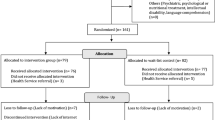ABSTRACT
OBJECTIVE: Women reporting subclinical eating disorder (ED) symptoms are at higher risk for the development of an ED. Preventive interventions should therefore be specifically tailored for this subgroup. Accordingly, the aim of this pilot study was to test the feasibility of the adapted Internet-based prevention program “Student Bodies™” for women with subclinical ED and to obtain effect size and sample size estimates for a subsequent randomized controlled trial. METHOD: Twenty-two women with subclinical ED participated in the 8-week intervention; pre-post data are available for 12 women. Measures of ED symptoms and established risk factors, such as weight and shape concerns, were assessed at preand post-intervention. RESULTS: Completers’ adherence and appraisal of the program were good. At post-intervention, completers reported significantly fewer ED symptoms and reduced weight and shape concerns. Pre-post-effect sizes ranged from medium to large. CONCLUSION: The pilot study showed the feasibility of the adapted online intervention and gave indications for its effectiveness.
Similar content being viewed by others
References
Stice E, Marti CN, Shaw H, et al. An 8-year longitudinal study of the natural history of threshold, subthreshold, and partial eating disorders from a community sample of adolescents. J Abnorm Psychol 2009; 118: 587–97.
Jacobi C, Morris L, Beckers C, et al. Maintenance of internet-based prevention: a randomized controlled trial. Int J Eat Disord 2007; 40: 114–9.
Stice E, Shaw H, Burton E, et al. Dissonance and healthy weight eating disorder prevention programs: a randomized efficacy trial. J Consult Clin Psychol 2006; 74: 263–75.
Taylor CB, Bryson S, Luce KH, et al. Prevention of eating disorders in at-risk college-age women. Arch Gen Psychiatry 2006; 63: 881–8.
Zabinski MF, Pung MA, Wilfley DE, et al. Reducing risk factors for eating disorders: targeting at-risk women with a computerized psychoeducational program. Int J Eat Disord 2001; 29: 401–8.
Stice E, Shaw H, Marti CN. A meta-analytic review of eating disorder prevention programs: encouraging findings. Annu Rev Clin Psychol 2007; 3: 207–31.
Wittchen H-U, Zaudig M, Fydrich T. Strukturiertes Klinisches Interview für DSM-IV Achse I und II. Goettingen, Hogrefe, 1997.
Hautzinger M, Bailer M, Worall H, et al. Beck- Depressions-Inventar (BDI). Testhandbuch (Bearbeitung der deutschen Ausgabe). 2nd ed. Bern, Huber, 1995.
Paul T, Thiel A. Eating Disorder Inventory-2. Deutsche Version. Göttingen, Hogrefe, 2004.
Hilbert A, Tuschen-Caffier B, Karwautz A, et al. Eating disorder examination-questionnaire: psychometric properties of the German version. Diagnostica 2007; 53: 144–54.
Franke GH. Brief Symptom Inventory von L. R. Derogatis (Kurzform der SCL-90-R) — Deutsche Version. Göttingen, Beltz Test GmbH, 2000.
Cohen J. Statistical power analysis for the behavioral sciences. New York, Academic Press, 1977.
Sass H, Wittchen HU, Zaudig M. Diagnostisches und Statistisches Manual Psychischer Stoerungen DSM-IV. Goettingen, Hogrefe, 1998.
Author information
Authors and Affiliations
Corresponding author
Rights and permissions
About this article
Cite this article
Völker, U., Jacobi, C. & Taylor, C.B. Adaptation and evaluation of an Internet-based prevention program for eating disorders in a sample of women with subclinical eating disorder symptoms: A pilot study. Eating Weight Disord. 16, e270–e273 (2011). https://doi.org/10.1007/BF03327471
Received:
Accepted:
Published:
Issue Date:
DOI: https://doi.org/10.1007/BF03327471




